|
|
|
Sort Order |
|
|
|
Items / Page
|
|
|
|
|
|
|
| Srl | Item |
| 1 |
ID:
076710
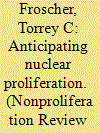

|
|
|
|
|
| Publication |
2006.
|
| Summary/Abstract |
Good intelligence is critical to support U.S. policy efforts to counter nuclear proliferation, but the historical record is mixed. This article reviews several past cases of nonproliferation success and failure, including the Soviet Union, China, India, Libya, Iraq, and the A. Q. Khan network. Intelligence frequently provides warning, and in some cases concrete and timely information has enabled nonproliferation successes. On the other hand, failures often result from a lack of detailed and specific information adequate to overturn erroneous assumptions or preconceptions. Improvements in intelligence are needed, but correct assessments of foreign programs cannot be guaranteed. A close and healthy relationship between intelligence analysts and policymakers is also a key factor in making the most of insights that are developed.
|
|
|
|
|
|
|
|
|
|
|
|
|
|
|
|
| 2 |
ID:
076722
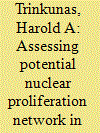

|
|
|
|
|
| Publication |
2006.
|
| Summary/Abstract |
From a proliferation perspective, Latin America has become one of the most denuclearized regions of the planet, and barring some revolutionary transformation of the international system, it is likely to remain so during the next decade. A combination of a paucity of credible external threats, widespread democratization, and the systematic resolution of border conflicts, particularly in the Southern Cone region, mean that states in the region do not see the value of acquiring nuclear weapons as a deterrent. The two states in the region with the most advanced civilian nuclear programs, Argentina and Brazil, have created a sophisticated mutual inspection regime that is an additional barrier to the development of any new proliferation network, and both states have a strong interest in maintaining a benign regional security environment. Venezuela's radical leader, Hugo Chávez, has expressed an interest in developing a nuclear power program, raising concerns among some observers over a potential new proliferation risk. However, Venezuela currently lacks the scientific and management expertise required to master nuclear technology within the next decade.
|
|
|
|
|
|
|
|
|
|
|
|
|
|
|
|
| 3 |
ID:
076711


|
|
|
|
|
| Publication |
2006.
|
| Summary/Abstract |
Over the past decades, the United States has had wins, losses, and draws in a continuing attempt to prevent a world of many nuclear powers. A review of that record suggests lessons or insights for future efforts to counter proliferation as well as for thinking about the 2016 proliferation future. Those lessons range from a need to adapt to the fact that critical U.S. security guarantees are no longer a nonproliferation "free good," through the recognition that "buying time" is a good in itself, to the importance of a successful nonproliferation policy that builds partnerships with other countries. Perhaps the most important insight from the proliferation policy past for thinking about the 2016 proliferation future, however, is that, repeatedly, fears of runaway proliferation have energized the United States and other governments to act together to make those fears a self-denying prophecy. With hard work and luck, this may yet happen again.
|
|
|
|
|
|
|
|
|
|
|
|
|
|
|
|
| 4 |
ID:
076717
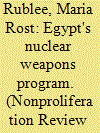

|
|
|
|
|
| Publication |
2006.
|
| Summary/Abstract |
The Egyptian nuclear weapons program - started in 1960 and closed by 1973 - can lend insights into today's potential proliferators. First, a number of signs indicating that Cairo was pursing a nuclear option were present, giving us insight into what type of signs we might see from countries seeking nuclear weapons today. While indicators do not necessarily connote intent, my research shows that in the Egyptian case, these signs were indeed warnings that Cairo was seeking a military nuclear capability. Second, a number of external and internal factors combined to shut down the nuclear program, and fortunately, some of these external factors are still applicable today, giving us potential tools to use in persuading other states to forgo nuclear weapons.
|
|
|
|
|
|
|
|
|
|
|
|
|
|
|
|
| 5 |
ID:
076720


|
|
|
|
|
| Publication |
2006.
|
| Summary/Abstract |
Northeast Asia is a nuclear tinderbox that could easily be set off, given rising regional tensions, widespread nuclear power capabilities, and the absence of strong regional security institutions. Given this context, states need to identify and seek to prevent "trigger events" - circumstances that could stimulate proliferation cascades. While it is important to continue the current emphasis on strengthening supply-side constraints (such as the Proliferation Security Initiative), new efforts to address the demand side are sorely needed. These efforts should include shoring up currently weakened global nonproliferation norms, facilitating direct talks among states on issues of military concern, and renewing efforts to address underlying sources of regional conflict (historical problems, territorial disputes, and the still unresolved Korean War). While difficult, these new approaches offer the best chance of keeping two and a half nuclear states in Northeast Asia from becoming six.
|
|
|
|
|
|
|
|
|
|
|
|
|
|
|
|
| 6 |
ID:
076719


|
|
|
|
|
| Publication |
2006.
|
| Summary/Abstract |
The primary factor driving nuclear proliferation in the Middle East is Israel's unacknowledged possession of nuclear weapons, something that the West, and in particular the United States, often ignores. The impact of Israel's nuclear deterrent on countries in the region, especially Iran and Egypt, is explored. Additionally, Iran's concern that Pakistan's nuclear weapons could one day come under the control of religious extremists is assessed. The possible consequences for the region if Iran acquires a nuclear capability are also examined. Only by acknowledging that countries like Iran fear a nuclear attack by Israel and the United States, and then incorporating this reality into concrete nonproliferation policy actions, can the danger of nuclear weapons in the Middle East be reduced and eventually eliminated.
|
|
|
|
|
|
|
|
|
|
|
|
|
|
|
|
| 7 |
ID:
076712


|
|
|
|
|
| Publication |
2006.
|
| Summary/Abstract |
Abstract In the past, international efforts to stop aspiring nuclear powers often came too late, well after decisions to acquire nuclear weapons had been taken and substantial progress in their programs had been made. To be effective, the United States and other key governments must intervene at an earlier stage. By better understanding the factors that may motivate particular countries to opt for nuclear weapons, the intelligence community can help policymakers devise country-tailored policies that address key concerns and reduce incentives for nuclear capabilities. Moreover, by studying the likely technical and political pathways individual countries may take toward a nuclear capability, the intelligence community may be able to identify early indicators of possible interest in nuclear weapons and help policymakers develop strategies for impeding or complicating progress along those pathways.
|
|
|
|
|
|
|
|
|
|
|
|
|
|
|
|
| 8 |
ID:
076715
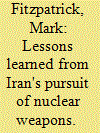

|
|
|
|
|
| Publication |
2006.
|
| Summary/Abstract |
Tipped off by Iran's efforts to acquire uranium enrichment and plutonium reprocessing technology, despite the economic illogic, the United States and its allies identified Tehran's nuclear weapons intentions early on and took effective action to stop several countries from inadvertently assisting that program. This postponed the worst-case scenario of when Iran might have the bomb, which for 15 years has been estimated at being five to ten years away. The intelligence success gave insufficient attention, however, to Iran's procurement efforts through non-state actors on the black market. Intelligence on Iran's motivations also will be important to devising effective policies. Those motivations include a need to achieve prestige, assert national pride, and secure dominance in the Gulf region. Iran's clerical leaders also see a nuclear capability as the best way to ensure their survival despite outside threats and internal opposition. At least 10 indicators of military involvement in the program have become known, reinforcing the judgment that Tehran is still intent on developing a latent nuclear weapons capability. Despite the confirmed evidence, the international community has not been able to change Iran's strategic calculations. The intelligence indicators will need to be corroborated if the world is to summon the will to put firm pressure on Iran to stop its nuclear pursuits.
|
|
|
|
|
|
|
|
|
|
|
|
|
|
|
|
| 9 |
ID:
076723
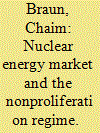

|
|
|
|
|
| Publication |
2006.
|
| Summary/Abstract |
This article presents a review of the sensitivities to proliferation attempts in each of the different stages of the commercial nuclear fuel cycle and within the nuclear power industry. As the global nuclear power industry may be on the brink of a major expansion that might rival its original growth at the inception of the nuclear age, the question is: Would this second expansion create uncontrollable proliferation risks in its wake? The basic answer is that the nuclear power industry in itself does not pose a direct proliferation threat; however, various elements of the nuclear fuel cycle could create different proliferation sensitivities if not safeguarded carefully. The first element of securing the nuclear fuel cycle is the understanding of which elements pose the greatest potential for successful proliferation attempts. These issues and several institutional and technical mitigation strategies to reduce the potential for possible proliferation are discussed here.
|
|
|
|
|
|
|
|
|
|
|
|
|
|
|
|
| 10 |
ID:
076718
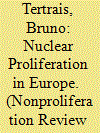

|
|
|
|
|
| Publication |
2006.
|
| Summary/Abstract |
Proliferation in Europe stopped in the 1960s due to the nuclear guarantee given by the United States and the European integration process. These factors still apply today but emerging nuclear programs in the European Union (EU) neighborhood and the distension of the transatlantic link make the possibility of a new nuclear country in Europe not completely unthinkable. Turkey would be a prime candidate. In addition, some isolated states could go nuclear if faced with a perceived security threat. Ukraine would be the most likely case. Finally, in extreme circumstances, an EU member could consider a nuclear program. In light of such possibilities, the U.S. security guarantee to Europe, including a nuclear dimension, remains an important nonproliferation instrument
|
|
|
|
|
|
|
|
|
|
|
|
|
|
|
|
| 11 |
ID:
076713


|
|
|
|
|
| Publication |
2006.
|
| Summary/Abstract |
The United States failed to prevent Pakistan from building nuclear weapons because U.S. officials never fully grasped Pakistan's perception of its security situation relative to India, especially after the 1971 Bangladesh war. Because Pakistani officials considered nuclear weapons essential to national survival, none of the measures deployed by the United States to dissuade Pakistan could have worked. This and other lessons of the Pakistani experience, including exploiting willing supply networks, providing financial and programmatic autonomy to key officials, and the consequent dangers of losing control of a dangerous program conducted in strict secrecy, are analyzed and their implications for future proliferants assessed
|
|
|
|
|
|
|
|
|
|
|
|
|
|
|
|
| 12 |
ID:
076708
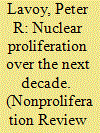

|
|
|
|
|
| Publication |
2006.
|
| Summary/Abstract |
The intensification of the Iranian and North Korean nuclear crises causes concern that deteriorating security conditions in the Middle East and Northeast Asia will lead additional countries to seek nuclear weapons. This special issue, which is based on a conference organized by the Center for Contemporary Conflict at the U.S. Naval Postgraduate School, examines the factors that are likely to shape nuclear proliferation in the next ten years. This introduction analyzes the conditions and events that might drive new countries to pursue nuclear weapons; the indicators and cautionary signs that can provide early warning that a country is trying to build nuclear bombs; and the policy measures that can be adopted to prevent or at least dissuade new proliferators. A novel analytical approach is developed, focusing on the role of nuclear myths and mythmakers to help analysts better understand and policymakers better manage nuclear proliferation over the next decade.
|
|
|
|
|
|
|
|
|
|
|
|
|
|
|
|
| 13 |
ID:
076716


|
|
|
|
|
| Publication |
2006.
|
| Summary/Abstract |
The decisions to abandon the pursuit of nuclear weapons by South Korea and Taiwan represent two of the most important cases of nuclear rollback during the Cold War. The cases differ in significant ways: While Taiwan's rollback emphasized capability reductions, South Korea's nuclear rollback mainly reflected changes in intent. One similarity was that despite their precarious security environment, both reversed their nuclear programs in the face of tremendous U.S. pressure. The United States is likely to remain central to these states' future nuclear narratives to ensure that they do not restart their programs. Changes in the threat environment, shifts in relations with the United States, or the belief that no one is watching could produce worrisome policy shifts in Seoul and Taipei. Several key questions for examination include: Why did they suspend their nuclear weapons programs? What specific pressures influenced rollback? How important was Washington in the process? How significant were the reversals? What could induce them to restart the programs? Understanding Seoul's and Taipei's decision-making is crucial to understanding rollback writ large. Failure to do so may invite an era in which the long-feared "nuclear dominoes" may fall
|
|
|
|
|
|
|
|
|
|
|
|
|
|
|
|
| 14 |
ID:
076724
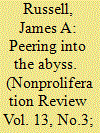

|
|
|
|
|
| Publication |
2006.
|
| Summary/Abstract |
The George W. Bush administration has successfully reoriented national policy and convinced the international community of the absolute necessity of denying weapons of mass destruction to terrorist groups. In addition to utilizing the tools of existing export control regimes, Washington promulgated the Proliferation Security Initiative and helped push through United Nations Security Council Resolution 1540 to expand the toolkit available to states to prevent the spread of dangerous technologies and weapons to terrorist groups. While these efforts are long overdue, they address only one aspect of the proliferation threat posed by non-state actors. Current efforts focus on the "demand" side of proliferation from terrorists but inexplicably leave unaddressed the role that a growing variety of non-state actors may play in shaping the supply side of an emerging 2016 proliferation market substructure. The proliferation supply network established by Pakistani scientist A. Q. Khan provides a precursor to a dangerous new proliferation environment dominated by transnational corporations, quasi-governmental entities, and individuals operating on the fringes of government control in weak or failing states that lack the will and the resources to implement effective export-control regimes. All states need to develop a more comprehensive and holistic view of the future role that a burgeoning plethora of non-state actors will play in nuclear proliferation by 2016.
|
|
|
|
|
|
|
|
|
|
|
|
|
|
|
|
| 15 |
ID:
076721


|
|
|
|
|
| Publication |
2006.
|
| Summary/Abstract |
This article reconsiders the conventional wisdom that the prospects for nuclear proliferation in Southeast Asia are too small to mention. After outlining the assumptions that underpin the conventional wisdom, it identifies recent regional and global trends that tend to weaken those assumptions and develops two proliferation scenarios, one centered on Burma and the other on Indonesia. It finds that the prospects for nuclear proliferation in Southeast Asia before 2016 remain nearly as remote as the conventional wisdom suggests, yet current trends suggest that the foundation for future proliferation may be laid during the coming decade. The scenarios suggest that attention ought to be focused not just on countries that are likely to proliferate, but on ways that Southeast Asian individuals might be drawn into regional and global proliferation networks.
|
|
|
|
|
|
|
|
|
|
|
|
|
|
|
|
| 16 |
ID:
076714


|
|
|
|
|
| Publication |
2006.
|
| Summary/Abstract |
South Africa's transition away from being a U.S. ally toward being a neutral country was followed by the development and then rollback of a nuclear weapons program. In South Africa's case, paranoia that the United States was abandoning it was a significant motive for going nuclear. Realism does not fully explain South Africa's desire for nuclear weapons, since the country faced no major strategic threats. Paranoia about communists and the loss of the United States as a major ally increased South Africa's sense of insecurity, thus it began to develop weapons and missiles. U.S. pressure increased in the late 1980s, and in 1989 the apartheid government began the process of surrendering power. South Africa signed the NPT, and in 1990 and 1991, it unilaterally disarmed. Lessons from the South Africa case include the critical role played by leaders in setting the direction of a country's strategic policy, and the unintended consequences of Western programs to promote peaceful energy. Democratic reforms may prove to be a successful long-term factor in reversing the development of nuclear weapons.
|
|
|
|
|
|
|
|
|
|
|
|
|
|
|
|
| 17 |
ID:
076709
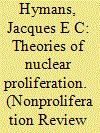

|
|
|
|
|
| Publication |
2006.
|
| Summary/Abstract |
Traditionally, American thinking on proliferation - whether by scholars or practitioners - has been dominated by the realist camp. According to this view, nuclear weapons are very valuable to states, so only strong supply-side control measures can stop the world's natural tendency toward rampant proliferation. However, realist intuitions have proven a very poor guide to the historical realities of nuclear proliferation. Therefore the idealist camp, which takes a different approach particularly to the demand side of the proliferation equation, has become increasingly prominent in academic circles and even in the policy world. Idealists are exploring the question of the demand for the bomb at three levels of analysis: international, domestic, and individual. This new research avenue is a very positive development, but idealism has its own potential pitfalls.
|
|
|
|
|
|
|
|
|
|
|
|
|
|
|
|
|
|
|
|
|